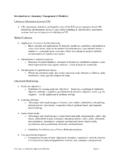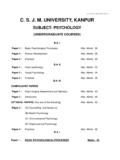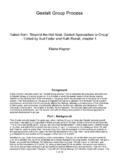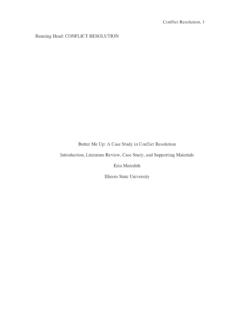Transcription of Based on a Study by Bernhard Riemann - SweMorph
1 analysis and synthesis On Scientific Method - Based on a Study by Bernhard Riemann Tom Ritchey Abstract - This article deals with the foundations of analysis and synthesis as scientific methods , and especially with the requirements for the successful application of these methods . Although analysis and synthesis always go hand in hand they complement one another there are important situations in which one method can be regarded as more suitable than the other. This concerns the question of which method is most appropriate as the primary point of departure for the Study of a given system or object of scientific inquiry. Keywords - analysis , synthesis , scientific method, Bernhard Riemann Dr. Tom Ritchey, Swedish Morphological Society, Stockholm, Sweden.
2 E-mail: Originally published in Systems Research, 1991, Vol. 8, No. 4, pp 21-41, Thesis Publishers, ISSN 0731 Revised version, 1996. (Downloaded from the Swedish Morphological Society: ) Section I Introduction A. Background The terms analysis and synthesis come from (classical) Greek and mean literally "to loosen up" and "to put together" respectively. These terms are used within most modern scientific disciplines -- from mathematics and logic to economy and psychology -- to denote similar investigative procedures. In general, analysis is defined as the procedure by which we break down an intellectual or substantial whole into parts or components. synthesis is defined as the opposite procedure: to combine separate elements or components in order to form a coherent whole.
3 Careless interpretation of these definitions has sometimes led to quite misleading statements -- for instance, that synthesis is "good" because it creates wholes, whereas analysis is "bad" because it reduces wholes to alienated parts. According to this view, the analytic method is regarded as belonging to an outdated, reductionist tradition in science, while synthesis is seen as leading the "new way" to a holistic Quite aside from the fact that it is the synthetic method which, historically, is associated with a reductionist approach to scientific inquiry, such interpretations arise from a fundamental misunderstanding of the relationship between these two methods . analysis and synthesis , as scientific methods , always go hand in hand; they complement one another.
4 Every synthesis is built upon the results of a preceding analysis , and every analysis requires a subsequent synthesis in order to verify and correct its results. In this context, to regard one method as being inherently better than the other is meaningless. REPRINT 2 There are, however, important situations in which one method can be regarded as more suitable than the other. This concerns the question of which method is most appropriate as the primary method or chief point of departure for the Study of a given system or object of scientific inquiry. This article deals with the foundations of analysis and synthesis as scientific methods , and especially with the requirements for the successful application of these methods . The article is Based upon a short, brilliant methodological Study by the 19th century mathematician Bernhard Riemann .
5 The Study in question is a fragment of Riemann 's last (unfinished) work, "The Mechanism of the Ear", written in 1866. In order to gain a better understanding of Riemann 's intentions in writing "The Mechanism of the Ear", this introduction continues with a biographical sketch and a discussion of the issues and controversies surrounding his last work. In Section II, the first 13 paragraphs of Riemann 's manuscript are presented, with detailed comments to each paragraph. It may well be that many readers already have a good working knowledge of the analytic and synthetic methods . I believe, however, that all of us -- practicing scientists and systems analysts as well as teachers and students -- have much to learn from Riemann 's discussion concerning the requirements for the applicability of these two methods .
6 B. Bernhard Riemann2 Bernhard Riemann was born in the little German kingdom of Hanover in 1826. He was the son of a rural priest and was apparently expected to follow in his fathers footsteps by studying theology. However, his talent for mathematics was discovered at an early age and his teachers at the German Gymnasium arranged for him to Study the classics of science. When he entered the University at the age of 20, his knowledge and general scientific background was far in advance of the curriculum offered at the time. Riemann entered the University at G ttingen in 1846, initially in order to Study theology. In 1887 he moved to Berlin to Study mathematics under Jacobi and Dirichlet, returning to G ttingen in 1849. In 1851 he put forward his doctoral dissertation and, in 1854, became Privatdozent -- that is, an unpaid lecturer.
7 Finally, in 1859, he became full professor of mathematics at G ttingen University. Riemann was famous during his own lifetime; he was recognized as a genius by the greatest mathematicians of the day. However, he remained "unemployed" -- had no formal position at the university and lacked regular income -- until he succeeded Dirichlet as professor in 1859. Years of economic hardship and overwork evidently so weakened his health that he died, 39 years old, in 1866. Probably more than any other single person, Riemann influenced the course of modern mathematics. During his short, intense career he published only a handful of papers, but all of them were important. Several have opened up new, productive areas of mathematical Study and a few have been nothing less than revolutionary.
8 Riemann is known primarily for the so-called Cauchy- Riemann equations, Riemann surfaces and Riemannian geometry, Riemann 's differential equation, the Riemann integral, Riemann 's zeta-function and the Riemann hypothesis. However, the basis for most of his discoveries seems to rest upon his fundamental development of the theory of 3complex functions. The methods he developed in this area led him to other discoveries in analysis , geometry, number theory and even hydrodynamics -- subjects which today are thought of as belonging to more or less separate areas of Riemann 's fundamental ideas on geometry were presented in his famous Inaugural Address of 1854, "On the Hypotheses which lie at the Foundations of Geometry".4 This short, non-technical work is undoubtedly one of the highlights in the history of science.
9 In it he analyses the basic assumptions which underlie geometry and develops unified principles not only for the classification of all then existing forms of geometry, but also for the creation of any number of new types of space. He later developed the basic analytical tools, which Einstein would subsequently use, in his theory of general relativity. Riemann 's work on aerodynamic equations ("On the Propagation of Plainer Air Waves of Finite Amplitude") resulted in new developments in the theory of hyperbolic partial differential equations and in the mathematical description of a shock wave -- a phenomenon that was demonstrated experimentally only some 50 years later. As late as the 1940's, his classical treatment of aerodynamic shock waves remained Riemann has also left mathematics with one of its outstanding, unsolved problems: the Riemann hypothesis.
10 In a short article, often referred to as "the most important paper ever published in number theory"6, Riemann tackled the classical problem of the number of prime numbers F(x) that are less than a given number x. By applying complex analysis to the problem he arrived at a hypothesis which has revealed much about the distribution of prime numbers and which provides a remarkable interaction between (mathematical) analysis and arithmetic. This represents only a small portion of Riemann 's most important work. However, the methods he developed in order to facilitate his discoveries, and the panoramic way in which he approached mathematical problems in general, have proved to be no less important. Much of his work is associated with methodological discussions, in which he attempts to display the very thought process which underlie his discoveries.











